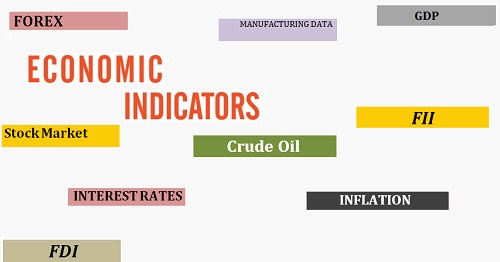In the United States more than 50% of their population invests in the stock markets (directly or via ownership of funds). In India, this figure is less than 2.5%. Ironically, India remains the fastest growing market for financial newspapers in the world. Does that mean that people want to research and stay updated but not invest?
I am sure that as awareness of stocks and financial products increases, as online accounts and faster internet connections penetrates deeper into the country and as our capital markets develop further, a lot more people in India will start investing in equity markets.

“This cannot be you. You must get on top of these things”.
Below, I will list out some of the most basic economic terms used in India which will help you understand and interpret key economic indicators and the impact of monetary policy on the economy. They will also help you extract a lot more information out of financial news.
The primary tools used by the government along with its agencies, to regulate the financial system can be classified as (i) Fiscal and (ii) Monetary policy tools.
- Fiscal policy refers to the policies framed by the government in order to regulate taxation and for allocation of budgets to various departments for their functioning. The annual economic survey and the annual budget list out these policies of the government. From paying the income tax, to our demand for better roads and infrastructure, everything is affected by the government’s fiscal policies.
- Monetary policy on the other hand is a term used to refer to the actions of our central bank i.e. the Reserve Bank of India (RBI). Besides printing money, the RBI through the use of monetary policy tools monitors and influences the movement of a number of macroeconomic indicators including interest rates, inflation rate, money supply and Gross Domestic Product (GDP) (these indicators are discussed below).
You may think of the RBI and the government as ‘money printers’ and ‘money managers’, both activities done with some careful planning. RBI prints new money primarily based on growth in the economy (i.e. the GDP) while the government manages this money to encourage growth in the economy.
Financial media regularly uses some basic economic terms while reporting a variety of data figures like stock market returns, GDP, inflation, FII flows, interest rates, industrial production etc. These figures are closely tracked by investors and analysts in order to predict the future health of the economy and make investment decisions on that basis. All these data points directly or indirectly indicate the state of the economy and business environment in the country.
Stock Market Returns: Stock market returns are a leading economic indicator and draw attention to the state of the economy. The stock market usually begins to decline before the economy declines and begins to improve before the economy begins to pull out of a recession.
Sometime back I wrote a detailed article on what stock market returns really indicate, where I compared the returns generated by the BSE 30 companies with the broader economy, available here- BSE Sensex 30 .
Manufacturing Activity: Manufacturing activity is another leading indicator of the state of the economy. A rise in the manufacturing activity of materials indicates a rising demand for consumer goods which is a sign of GDP growth. Further, a rise in manufacturing activity creates employment as more workers are employed in the manufacturing sector. This new employment results in more wages being paid, all of which drives consumption. In India, the Index of Industrial Production (IIP) data is released on a monthly basis which indicates the level of manufacturing activity in the economy.
Foreign Institutional Investors (FIIs): FIIs are foreign entities which are allowed to invest in the Indian share markets and are a major source of liquidity for the stock markets. When FIIs invest large amounts in the Indian share markets, it is seen as a seal of approval by sophisticated investors who back themselves with detailed diligence and study of the future prospects of the economy. For this reason FII buying often indicates a positive economic outlook and vice-versa.
View: The above view on FIIs may well be the one widely accepted. In my experience, FII buying and selling indicates nothing about long term prospects. FII’s are just as likely as any other category of investors to indulge in irrational buying and selling. Given the academic nature of this article, I nevertheless included this as an indicator.
Foreign Direct Investment (FDI): FDI which is a direct investment into the country from an entity in another country, either by setting up a new company or by way of a merger, acquisition etc., indicates the positive sentiment of overseas investors on the future business environment of the country. To view the latest FDI investments into India, you can visit here.
Part II – Click here to continue reading about the instruments of monetary policy in India.


it is very helpfull one….thank you
mind blowing